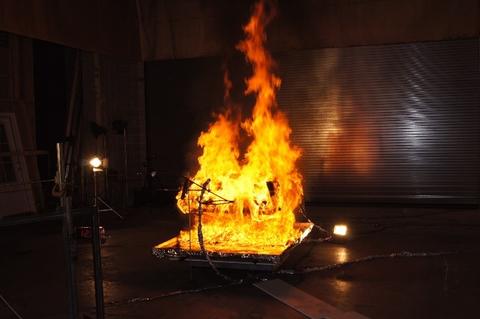
The Flammability Reduction Group recently completed a two-week-long series of full-scale furniture fire experiments in the National Fire Research Laboratory (NFRL). These tests focused on quantifying the ability of barrier fabrics to reduce the flammability of residential upholstered furniture (RUF) - specifically, how barrier fabrics can reduce fire size (heat release rate, HRR) and delay fire growth (i.e. increase time to peak HRR). In the United States, RUF Fires are the single largest cause of civilian deaths in home fires (>600 deaths and >1,100 injuries per year).[1]
Triplicate tests were conducted on armchair mock-ups constructed with a polyurethane foam seat cushion, polyurethane/plywood arms, and a polyester-filled back cushion, each wrapped with a barrier fabric and a polypropylene cover fabric. Six different commercially available barrier fabrics were tested, using fiber materials (glass, cellulose, hydrated silica, para-aramid, oxidized polyacrylonitrile) without any additional flame retardant chemicals; a set of control experiments was conducted without a barrier fabric, using only the polypropylene cover fabric over each cushion. Sample construction is typical of that of commercially available RUF; a detailed description of sample construction is provided here: Chair Mockup Schematic.pdf .
Test Results
As seen in Video 1 the presence of a barrier fabric can significantly delay fire growth and reduce peak fire size (HRR). The two barrier fabrics used in this video are inexpensive and commercially available. Barrier 4 (center) is a fiberglass fabric. Barrier 1 (right) is a rayon, cotton, and hydrated-silica fiber blend that is currently used to protect mattresses such that they can meet the requirements of 16 CFR Part 1633, the Federal Standard for the Flammability (open flame) of mattress sets [2].
In these experiments, the armchairs constructed without a barrier fabric (left) supported rapid fire growth with a peak heat release rate of almost 3 MW, which would likely lead to flashover in a typical living room approximately 2-3 minutes after ignition [3]. With a barrier fabric (center and right), peak heat release rate was reduced by up to a factor of 3 and delayed until 10 to 20 minutes after ignition. Note: fire department response time objectives are between 9 minutes and 14 minutes, depending on the demand zone (i.e. urban vs. rural) [4]. More information regarding basic fire dynamics (e.g. definitions of hire size, heat release rate, and flashover) is available here .
What’s Next?
Currently, there is no national standard to assess the flammability of residential upholstered furniture in response to an open flame. A California standard assessing the smolder resistance of materials used in upholstered furniture (Technical Bulletin 117-2013 [5]) exists; however, material response to smoldering and flaming ignitions sources may vary. For example, without the use of a barrier fabric, furniture constructed with the polypropylene cover fabric (experiment at left in Video 1) passes the California Technical Bulletin 117-2013 tests.
Ongoing work by the Flammability Reduction Group at NIST is focused on developing a standard composite test method (bench-scale) that can assess the effectiveness of technologies to reduce the flammability of RUF without chemically active flame retardants (e.g. barrier fabrics) and correlating performance in these bench-scale tests with full scale measurements.
More information about the Reduced Flammability of Residential Upholstered Furniture Project is available at: https://www.nist.gov/programs-projects/reduced-flammability-residential-upholstered-furniture-project
[1] J.R. Hall Jr, “Estimating Fires When a Product is the Primary Fuel but Not the First Fuel, With an Application to Upholstered Furniture”, NFPA, 2014.
[2] Consumer Product Safety Commission 16 CFR Part 163, “Standard for the flammability (Open Flame) of Mattress Sets; Final Rule,” CPSC, 2006. https://www.cpsc.gov/s3fs-public/pdfs/blk_media_mattsets.pdf
[3] M.C Bruns, NIST Technical Notes 1920, “Predicting the Effects of Barrier Fabrics on Residential Upholstered Furniture Fire Hazard,” NIST, 2016. https://nvlpubs.nist.gov/nistpubs/TechnicalNotes/NIST.TN.1920.pdf
[4] NFPA 1720, “Standard for the Organization and Deployment of Fire Suppression Operations, Emergency Medical Operations, and Special Operations to the Public by Volunteer Fire Departments, 2010 Edition,” NFPA, 2010. https://www.nfpa.org/Codes-and-Standards/ARCHIVED/Safer-Act-Grant/NFPA-1720
[5] State of California Department of Consumer Affairs, Technical Bulletin 117-2013, “Requirements, Test Procedure and Apparatus for Testing the Smolder Resistance of Materials Used in Upholstered Furniture,” 2013. https://www.bearhfti.ca.gov/about_us/tb117_2013.pdf

